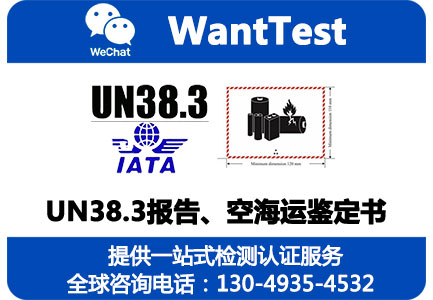Power Bank UN38.3 report UN38.3 Test summary with CNAS
Step 1: Apply for application
Determine customer information
a. Which city's aviation products are exported by customers;
b. Whether the customer's products are shipped separately or in conjunction with other products.
2. Fill in the UN38.3 application form
3. Provide battery specifications
4. Provide 18 samples

Step 2: Quote
Determine the test time and corresponding costs based on the information provided.
Step Three: Payment
After the applicant confirms the quotation, it signs the case application form and service agreement and pays the full project fee.
Step 4: Testing
The laboratory performs a full set of tests on the applied product according to the relevant testing standards.
Step 5: Test passed and report completed
Step 6: The project is completed and a dgm certificate is issued
What is the difference between UN38.3 authentication and msds
Usually when many people do battery testing, UN38.3 and msds are confused or considered to be the same certification, which has a great impact on handling the test. msds is a chemical safety technical specification, is a document on lithium battery composition and emergency treatment, UN38.3 is a safety test on lithium battery. Because lithium batteries are shipped by air, UN38.3 and msds are often required to be provided together, so many people mistakenly think that UN38.3 is msds.
UN38.3 test summary
msds Chemical Safety Data Sheet
msds (material safety data sheet) is a chemical safety data sheet, which can also be translated into a chemical safety data sheet or a chemical safety data sheet. It is used by chemical manufacturers and importers to clarify the physical and chemical characteristics of chemicals (such as pH value, flash point, flammability, reactivity, etc.) and the possible harm to the user's health (such as causing, teratogenic, etc.) One document.
In European countries, the material safety technology / data sheet msds is also called safety technology / data sheet sds (safety data sheet). The International Organization for Standardization (ISO) uses SD terms, whereas the US, Canada, Australia, and many Asian countries use MSD terms.
msds is a comprehensive legal document on chemical characteristics provided by chemical production or sales enterprises to customers in accordance with legal requirements. It provides sixteen items, including physical and chemical parameters of chemicals, explosion performance, health hazards, safe use and storage, spill disposal, first aid measures, and related laws and regulations.
version
· Iso international universal version
· Eec version (EU)
· Osha version (US)
· Ansi version (US)
· Whmis (Canada) and Chinese version;
· Different language versions (Chinese, English, German, French, etc.)
UN38.3 new version (rev.5) release and content introduction
united nations "Recommendations on the transport of dangerous goods: manual of tests and criteria" rev.5 was released on December 31, 2009 and will replace the current version rev.4-2003. According to relevant news, transport regulatory authorities in some countries and regions have begun to use the new version, but some regions will be implemented on January 1, 2011. In the new version of the Manual of Tests and Standards, Section 38.3 of the Manual for Testing of Lithium Metals and Lithium-Ion Batteries still has relatively large changes.
Changes
Compared with the original version of UN38.3 rev.4-2003, the main changes in the new version are as follows:
1. There are obvious changes in the definition of large batteries and cells:
Rev.4 defines a large battery as a battery with a total anode lithium content of more than 500g in a fully charged state. Large cell refers to the cell with anode lithium content or lithium equivalent content greater than 12g when fully charged.
In the new version rev.5, large batteries are defined as lithium metal or lithium ion batteries with a total weight of more than 12kg. Definition Large-sized cells refer to cells with a lithium anode content of more than 12g when fully charged; for lithium-ion cells, a battery with a rated watt-hour greater than 150wh.
2. The definition of lithium equivalent content in the original version has been removed in the new version rev.5. For lithium-ion batteries and batteries, the rated watt-hour data is used instead. The rated watt-hour is defined as the product of the rated capacity of the battery (cell) and the rated voltage.
3. Compared with the rev.4 version, the test items, test methods, and determination standards included in the new version rev.5 have not changed, but the number and status of batteries or cells required for each test item are relatively large The changes are mainly shown in the following table:
Although the new version has relatively large changes in the number of test samples and battery status, but since the test scheme and method have not changed, and the main test process has not changed, the new version will not be noticeable in the test cycle. Variety.
As the current IATA (International Air Transport Association) 54th version of the dgr rule stipulates that the prerequisite for air transport of lithium batteries is to meet the test requirements of UN38.3, the dgr rule does not specify the version of UN38.3. In China, the "Mh / t 1020-2009 lithium battery air transport specification" formulated by the General Administration of Civil Aviation of China in March 2009. Although the UN38.3 version quoted is rev.4, it only indicates that it refers to this version. When the specification was introduced, it did not specify the UN38.3 version to be complied with. In this regard, ebo also contacted the relevant personnel of the Civil Aviation Administration of China's Transportation Department and the Aviation Safety Technology Center to communicate when the new version of UN38.3 was adopted. The relevant personnel of the Civil Aviation Administration of China stated that under the conditions of the new version's release, the new version will be given priority Perform test evaluation.

